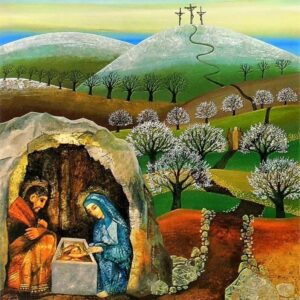The Manger and the Cross
I saw a wonderful depiction of baby Jesus by the German artist Beate Heinen years ago, and it is the best depiction of the Christmas story I’ve ever seen. The painting is called “The Manger and the Cross.”

The newborn Christ-child is in a feeding trough that looks like a coffin. Outside is a path that starts with budding trees and green grass, but at the end, the trees are barren, the ground brown and dead. At the foot of three crosses, the land is gray and colorless, a place of death. It’s Golgotha, and this is the path Jesus trod, this was the purpose of his life.
The cradle must include the cross because the cross sheds light upon the cradle. It started in Bethlehem and ended in Calvary. Christmas is really the beginning of Easter. Compare and contrast these two holy days:
When the Christ child was born at Christmas, the wisemen asked, “Where is the one who has been born king of the Jews?” Now His royal title, “King of the Jews,” is affixed to the cross for all to see. In the manger, Christ was weak, frail and dependent—like any baby. On the cross, he’s weak and frail, yet resigned to do his Father’s will—as our Savior. At His birth, something strange happened in the heavens: A star in the night sky. When he was crucified, there was darkness at noon.
Among the first to come to Him at His birth were the Gentile Magi, drawn by the light of the star. The first to respond to the cross was the Gentile centurion, awakened by the shaking of the earth. From the cradle, Jesus was taken away to Egypt, but then returns. In the crucifixion, Jesus dies, seemingly taken from this earth, but is brought back to life, through the resurrection.
At his birth, Joseph and Mary were present. At his death Joseph and Mary were also present, though different people. After his birth, Jesus was laid in a stone-cold trough. After the crucifixion, Jesus was laid in a stone-cold tomb. At Jesus’ birth, Mary wrapped him in cloths and placed him in a manger. After Jesus’ death, Joseph wrapped him in cloths and placed him in a tomb.